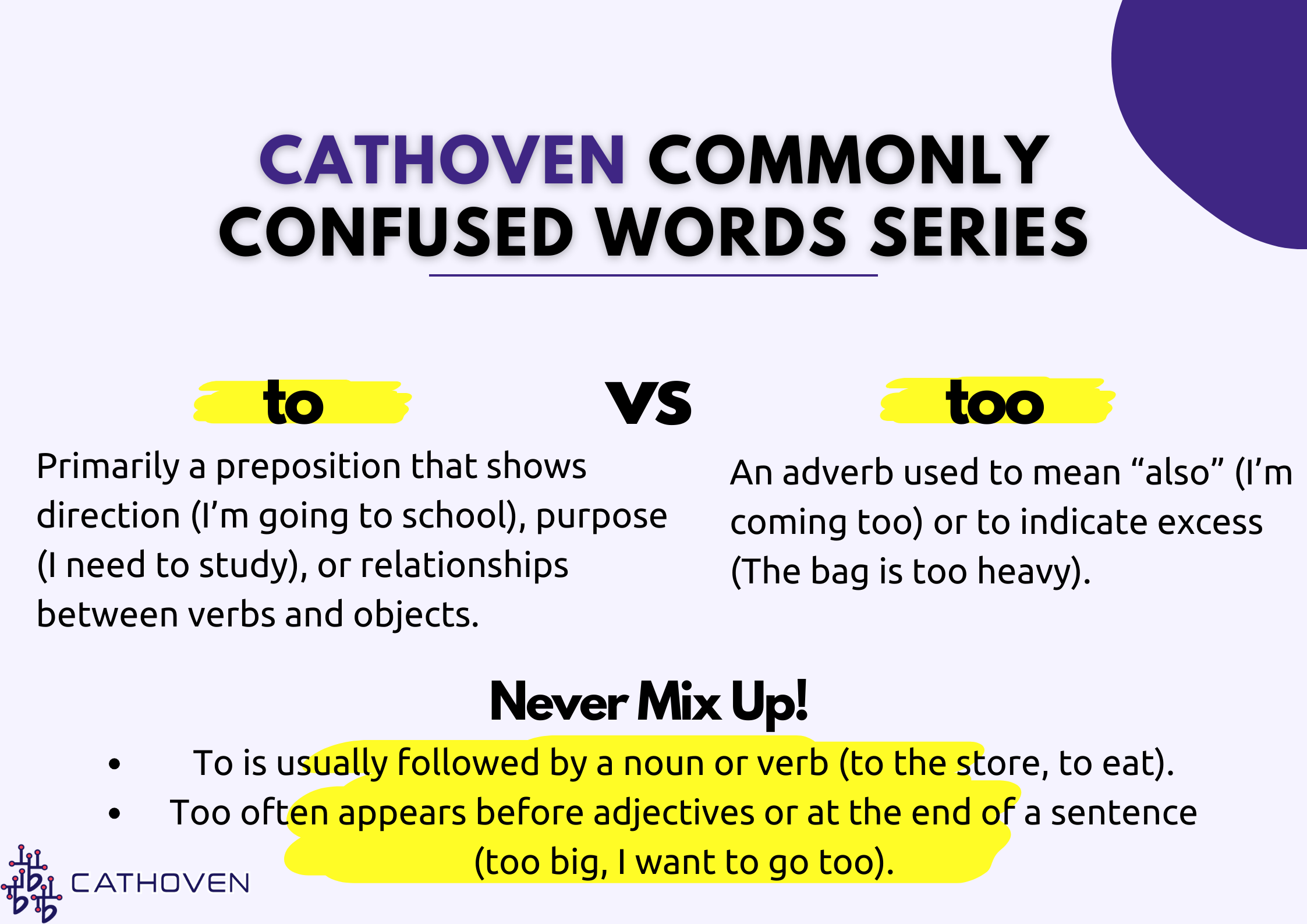“To” and “too” are two small but frequently confused words in the English language. Both are commonly used in everyday conversations and writing, but they serve different functions. Understanding when to use “to” versus “too” is essential for clear and correct communication.
In this post, we’ll explore the differences between these two words, provide examples of how to use each one correctly, and offer CEFR insights to help learners at different levels grasp their meanings and usage.
What is “to”?
“To” is primarily a preposition that indicates direction, destination, purpose, or a relationship between actions and objects. It is one of the most frequently used words in the English language, appearing in various sentence structures.
- CEFR Level: A1
“To” is introduced early, at the A1 (Beginner) level, as it is essential for constructing basic sentences that describe movement or intentions.
Examples of “to” in sentences:
- I’m going to the park. (A1)
- Basic example showing direction.
- She gave the book to her friend. (A2)
- Example demonstrating “to” as a way of indicating the receiver of an action.
- He studies to become a doctor. (B1)
- Example illustrating purpose or intention.
What is “too”?
“Too” is an adverb that typically has two meanings: (1) “also” or “in addition,” and (2) “excessively” or “more than necessary.” Unlike “to,” which indicates direction or purpose, “too” focuses on adding information or expressing intensity.
- CEFR Level: A2
Learners usually encounter “too” at the A2 level, especially when they begin expanding their vocabulary and sentence complexity.
Examples of “too” in sentences:
- I want to go too. (A2)
- Example where “too” means “also.”
- It’s too hot outside to play. (B1)
- Example where “too” means “excessively.”
- She speaks too quickly for me to understand. (B2)
- Example showing both “too” as an adverb and how it impacts the following action.
Examples for Using "To"
A1 Level (Beginner):
- I go to school every day.
- Simple sentence indicating direction.
- She wants to eat pizza.
- Basic use showing purpose or intention.
A2 Level (Elementary):
- He is traveling to London tomorrow.
- Using “to” for destination in a more specific context.
- They are going to the cinema to watch a movie.
- Combining movement with intention.
B1 Level (Intermediate):
- We decided to study together for the exam.
- More complex sentence showing intention with a decision.
- The package was sent to the wrong address.
- Demonstrating how “to” can be used for a recipient.
B2 Level (Upper-Intermediate):
- She has been invited to speak at the conference.
- More advanced use with the passive voice.
- The key to success is hard work and persistence.
- Showing abstract usage to indicate relationship or purpose.
C1 Level (Advanced):
- He aspired to become a renowned scientist in his field.
- More advanced vocabulary and purpose-driven sentence.
- The company’s efforts to innovate have led to global recognition.
- Using “to” to express causality and outcome in a formal context.
Examples for Using "Too"
A2 Level (Elementary)
- I’m going to the park too
- Simple use of “too” to mean “also.”
- The soup is too hot to eat.
- Basic sentence showing excessiveness.
B1 Level (Intermediate):
- She talks too much in class, which distracts the other students.
- Example of “too” expressing excessive behavior.
- I want to go too, but I have work to do.
- More complex structure with “too” meaning “also.”
B2 Level (Upper-Intermediate):
- His explanation was too complicated for me to understand.
- Showing how “too” impacts the following action or ability.
- It’s too late to change our plans now.
- “Too” indicating that time has passed beyond what’s reasonable or possible.
C1 Level (Advanced):
- The new regulations are too strict for many companies to comply with.
- Complex sentence showing excessiveness in a formal or technical context.
- Her ambitions are too high, given the current state of the market.
- “Too” used in a more abstract or evaluative sense, showing an excessive or unrealistic expectation.
Key Differences Between "To" and "Too”
- To: Primarily a preposition that shows direction (I’m going to school), purpose (I need to study), or relationships between verbs and objects.
- Too: An adverb used to mean “also” (I’m coming too) or to indicate excess (The bag is too heavy).
A helpful tip to remember the difference is:
- To is usually followed by a noun or verb (to the store, to eat).
- Too often appears before adjectives or at the end of a sentence (too big, I want to go too).
Cathoven’s AI-powered tools can assist teachers and learners in practicing important concepts through real-life scenarios. For example, the Exercise Creator allows you to generate comprehension exercises by simply providing a text. To make it easier, we’ve created an example text for you—just click ‘use example text‘ to get started. Once the text is in place, you can create multiple-choice questions, true/false, and short-answer questions.

Click the “use an example text” below and start creating questions to measure your students’ understanding of to and too!
Try with your own text right now (simple version)
Multiple choice
Number of remaining chances: 3
The result will be shown here:
*No credit card or upfront payment required to use
Frequently Asked Questions about "To" vs "Too"
"To" is a preposition used to show direction, purpose, or relationship between actions and objects.
"Too" is an adverb that means "also" or "excessively."
Remember, "to" is often used with verbs or nouns, and "too" is usually used with adjectives or at the end of sentences to mean "also" or "excessively.”
